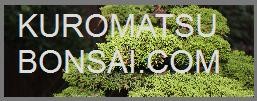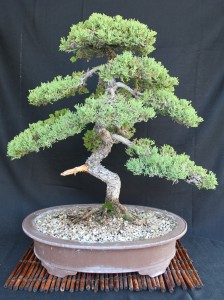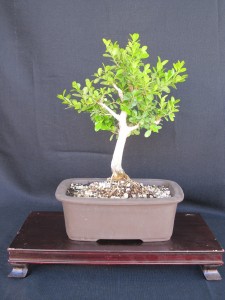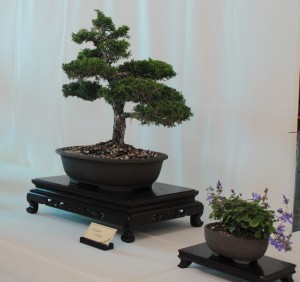Bonsai Care
Bonsai Care
Let’s Start With the Basics
If you are reading this page, then it is likely you just purchased a bonsai, or were given one, or inherited one, or adopted one. So let’s start literally from zero. First:
What kind of tree is it?
Fifteen years ago, you would have had to ask someone. Now you can log onto the Web and have the answer in a few minutes. I have seen quite a few folks find a bonsai forum, post a photo and ask the members. This is fine if you can wait for an answer. Unlike a number of other bonsai websites, I have tried to post a photograph of a “real world” bonsai specimen from every species in my collection. I don’t have every possible species used for bonsai covered yet, but I have managed to cover the species of plant most commonly used, so chances are if you look around, you will find something similar to what you have.
Is Your Tree Healthy?
Take a good look at your tree. Does it look healthy? More important, does it look like a bonsai, or has it gotten ragged looking? Are the leaves a healthy green, or are they yellow or brown? Here is the most important question for every bonsai, no matter what it is, or where it came from: WHEN WAS THE LAST TIME YOUR BONSAI WAS REPOTTED? Because bonsais grow in a very small volume of soil, most bonsais will burn the nutrients out of the soil in as little as one growing season. The soil will also eventually compact or “cake up,” impairing drainage and eventually causing root rot. Is your Juniper bonsai turning yellow from the bottom up? Is your Ficus bonsai dropping leaves? Is your Chinese Elm bonsai losing leaves and it is not fall yet? Chances are, you have a soil problem, and root rot. The vast majority of problems with bonsai can be traced back to the soil – either bad soil, or the tree went too long without repotting. THE SOIL IS THE TREE’S LIFELINE. Repotting a bonsai is like changing the oil in your car. It has to be done regularly. Unlike your car, a bonsai can go a year without being repotted. Some can go two years. Let them go any longer than that and you are asking for trouble.
Here’s Some Bad News:
Most bonsais you purchase online or at a “big box” store are mass produced in China, and container shipped around the world. The growers use a peaty soil that retains moisture well, and they glue rocks to the surface to further retain moisture. The do this because the trees are not watered at all during shipping. This practice keeps the tree alive during shipping without it being watered. However, when you, the purchaser brings it home, and starts trying to keep the tree on a regular watering schedule, well, that is usually when the trouble starts. It is almost impossible to keep a bonsai potted in poorly draining soil on a regular watering schedule. This is because how quickly the soil dries out depends on external factors such as the weather and the surrounding temperature. You end up watering too much or not enough, and eventually the tree gets root rot. The tree announces this by getting pale, the leaves turn yellow and drop off, or in the case of a juniper, the tree starts to dry up and die. How do you prevent this? By making sure your tree is potted in good soil.
Now For the Scary Part:
If you have not repotted your bonsai in the past year, TAKE IT OUT OF THE POT AND EXAMINE THE SOIL AND ROOTS. The soil should be granular and well –draining – as in, when you water, you should see water running out the bottom of the pot quickly. This should happen immediately with a small bonsai, and on a count of three with a medium sized tree, and on a count of five with a large one. The tree should not be rootbound. The soil should not be a dry brick, nor should it be a gloppy mess. You should always have some spare bonsai soil available. Even if you have only one or a few trees, you never know when a cat or an opossum will knock one over.
Repotting:
If you are going to prune the tree or shape it, this should be done before repotting. To repot, first break up the soil with a chopstick. If you do not have a chopstick or a root hook, use the center prong on a cultivator, but be careful. If the tree is something other than a Black Pine or an Azalea, you can wash the soil off the roots with a hose. Prune away any overly long roots with a sharp scissors. If the tree has root rot, prune away any dead roots. Either have a new pot available, or wash and clean the existing pot for reuse. Place drainage screens over the drainage holes and wire them into place with bonsai wire. If you do not have bonsai wire, copper electrical wire or steel baling wire will work. Place a layer of soil into the bottom of the pot. Prune the tree’s roots so that there is a ¼” gap between the outside edges of the root mass and the inside edges of the pot. Place the tree back in the pot and wire it into position of necessary. Fill the soil in around the tree’s roots. Make sure not to leave any air pockets in the soil. Water the tree after you repot it, until water runs out the bottom of the pot.
Watering:
Bonsai are supposed to be grown in a loose, fast draining soil mixture, and most are intended to be watered on a daily basis, or at least every second or third day. However, if you are caring for an existing bonsai you bought or were given, observe it carefully to see how well the water drains from the soil. There is nothing worse than leaving a bonsai constantly waterlogged – unless the tree is a Bald Cypress . Never water unless you are sure that the tree needs it. Use a chopstick to probe the soil and check for moisture under the surface.
Fertilizer:
Bonsais need supplemental fertilizer. The small volume of soil they grow in cannot hold enough nutrients to keep them healthy for very long. The rule with fertilizer is, USE IN MODERATION. Overfertilizing will kill a bonsai quickly. There are two kinds of fertilizer: Chemical and organic. Chemical fertilizers work quickly, but also kill quickly if used in excess. Organic fertilizers are easier to use, because the tree will take what nutrients it needs, but they tend to smell, and can attract pests. Whatever you choose, use in small quantities until you know the effect it has on the tree.
Location:
Where you put your tree is just as important as the soil and watering All trees need light and fresh air. While that tree would look beautiful on your coffee table, keeping it there is a really bad idea. If you want to use a bonsai as a table centerpiece, keep it outside on the patio table. While some bonsai are sold as indoor bonsai, “indoors” usually means in a south facing window, or under a really powerful grow light. The vast majority of bonsai do best in a sheltered outdoor location, such as a patio with a lattice cover, and should only be brought indoors to protect them from snow and frost. For purposes of siting, you do need to know what kind of bonsai you have. Pines and Junipers will have different needs from an Azalea or a Ficus.
Pests and Diseases:
Watch your tree carefully. It is pretty easy to tell when a tree gets infested with insects or fungus. Observe what is going on. If you see aphids, or scale insects, or you see a fungus on the leaves, take appropriate action.
Enjoy Your Bonsai!
There are lots of ways to enjoy bonsai. They are beautiful to look at, of course. You can simply sit in your garden and stare at them, and enjoy the peaceful feeling it gives. They also make nice display pieces, either in your yard, or for a temporary indoor display. Bonsai also make wonderful subjects for photography, and you may discover a new hobby photographing your bonsai.



